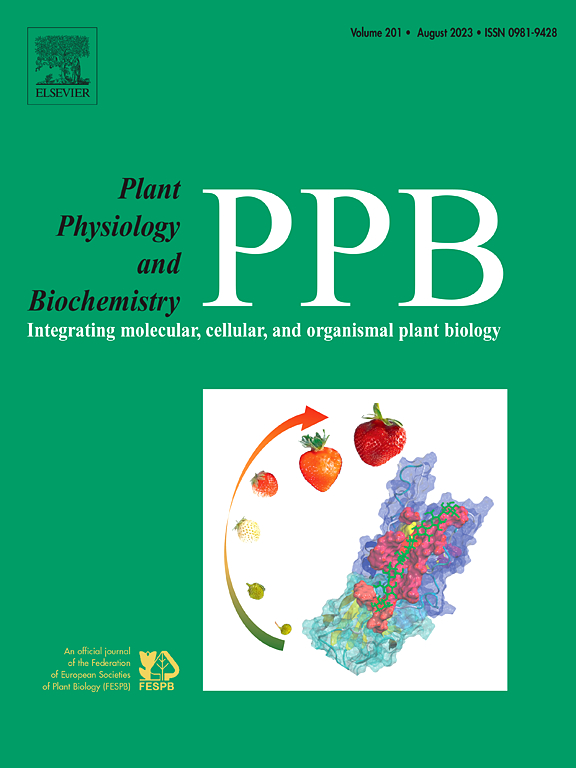干旱胁迫下鹰嘴豆ABC转运蛋白及其表观遗传调控
IF 6.1
2区 生物学
Q1 PLANT SCIENCES
引用次数: 0
摘要
鹰嘴豆(Cicer arietinum L.)是全球重要的豆类作物,为数百万人提供膳食蛋白质。然而,由于干旱胁迫,它遭受了重大的产量损失,因此,鉴定赋予耐旱性的基因是至关重要的。atp结合盒(ABC)转运蛋白是植物生长发育过程中至关重要的蛋白质,促进脱落酸(ABA)等植物激素的运输,帮助植物适应干旱条件。在本研究中,我们鉴定了鹰嘴豆中121个ABC转运蛋白基因,将其分为8个亚科。与其他作物一样,CaABCG家族是最大的,有48个成员,而CaABCE家族只有一个蛋白质。结构分析显示其具有保守结构域,包括Walker a、B基序和ABC特征基序。在CaABCG亚家族和CaABCC亚家族中,重复率最高。利用两种鹰嘴豆耐旱性比较基因型的根组织RNA-seq和全基因组亚硫酸盐测序(WGBS)数据,研究人员发现细胞嘧啶残基DNA甲基化可能在干旱胁迫下调控这些基因。值得注意的是,CaABCG41基因被鉴定为干旱响应基因,表现出显著的上调(p <;0.05)和高甲基化(q <;干旱胁迫下耐旱基因型与干旱敏感基因型的差异为0.01)。因此,CaABCG41具有培育耐旱鹰嘴豆品种的潜力。本文章由计算机程序翻译,如有差异,请以英文原文为准。
The ABC transporters and their epigenetic regulation under drought stress in chickpea
Chickpea (Cicer arietinum L.) is a globally essential pulse crop, providing dietary protein for millions. However, it suffers significant yield losses due to drought stress, therefore, identification of genes that confer drought tolerance is crucial. The ATP-binding cassette (ABC) transporters are vital proteins in plant growth and development, facilitating the transport of phytohormones like abscisic acid (ABA) that helps plants adapt to drought conditions. In this study, we identified 121 ABC transporter genes in chickpea, categorized into eight subfamilies. Consistent with other crops, the CaABCG family was the largest, with 48 members, while the CaABCE family had only one protein. Structural analysis revealed a conserved domain organization, including Walker A and B motifs and the ABC signature motif. Both segmental and tandem duplications were observed, with the highest duplication in the CaABCG and CaABCC subfamilies. Using RNA-seq and Whole Genome Bisulfite Sequencing (WGBS) data from the root tissues of two chickpea genotypes contrasting in drought tolerance, we found that DNA methylation at cytosine residues might regulate these genes under drought stress. Notably, the CaABCG41 gene was identified as drought-responsive, showing significant upregulation (p < 0.05) and hypermethylation (q < 0.01) in the drought tolerant genotype compared to the drought sensitive genotype under drought stress. CaABCG41 thus holds potential for developing drought-tolerant chickpea cultivars.
求助全文
通过发布文献求助,成功后即可免费获取论文全文。
去求助
来源期刊
CiteScore
11.10
自引率
3.10%
发文量
410
审稿时长
33 days
期刊介绍:
Plant Physiology and Biochemistry publishes original theoretical, experimental and technical contributions in the various fields of plant physiology (biochemistry, physiology, structure, genetics, plant-microbe interactions, etc.) at diverse levels of integration (molecular, subcellular, cellular, organ, whole plant, environmental). Opinions expressed in the journal are the sole responsibility of the authors and publication does not imply the editors'' agreement.
Manuscripts describing molecular-genetic and/or gene expression data that are not integrated with biochemical analysis and/or actual measurements of plant physiological processes are not suitable for PPB. Also "Omics" studies (transcriptomics, proteomics, metabolomics, etc.) reporting descriptive analysis without an element of functional validation assays, will not be considered. Similarly, applied agronomic or phytochemical studies that generate no new, fundamental insights in plant physiological and/or biochemical processes are not suitable for publication in PPB.
Plant Physiology and Biochemistry publishes several types of articles: Reviews, Papers and Short Papers. Articles for Reviews are either invited by the editor or proposed by the authors for the editor''s prior agreement. Reviews should not exceed 40 typewritten pages and Short Papers no more than approximately 8 typewritten pages. The fundamental character of Plant Physiology and Biochemistry remains that of a journal for original results.

 求助内容:
求助内容: 应助结果提醒方式:
应助结果提醒方式:


